| |
Glossary of Coral Reef Terminology - L
La Niña - a phenomenon characterized by unusually cold ocean temperatures in the eastern Equatorial Pacific, compared to El Niño, which is characterized by unusually warm ocean temperatures in the eastern Equatorial Pacific |
label - a compound or atom that is either attached to, or incorporated into, a macromolecule and is used to detect the presence of a compound, substance, or macromolecule in a sample; also called a 'tag' |
labeled - to mark substances in a way that they can easily be identified. In an organism, substances may be labeled using stable isotopes or harmless radioactive components so that they can be traced, analyzed or measured |
labial - pertaining to the lips |
labium - any lip-like structure |
Lacey Act - the Lacey Act, passed in 1900, and amended several times, makes it unlawful to import, export, transport, sell, buy, or possess fish, wildlife, or plants taken, possessed, transported, or sold in violation of any federal, state, foreign, or Native American tribal law, treaty, or regulation |
lacriform - tear-drop shaped; also called "dacriform" |
lacuna - a cavity ("little lake") in a matrix-like substance. For example, cartilage cells (chondrocytes) are located in lacunae in the cartilagenous matrix; bone cells (osteocytes) are located in lacunae in bone matrix |
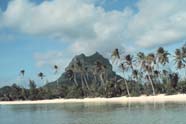
A lagoon in Bora Bora. (Photo: Dr. Anthony Picciolo/NOAA)
|
lagoon - a warm, shallow, quiet waterway separated from the open sea by a reef crest |
lagoon slope - the back reef on a barrier or atoll reef |
lambert - unit of brightness of light |
lanceolate - spear-shaped, tapered at both ends |
lanceolate - shaped like a lance head |
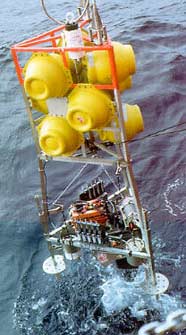
A lander system being deployed. The part with the large yellow structures is the floatation rack (Photo: KC Denmark)
|
lander system (benthic lander) - a scientific instrument system designed for temporary deployment on the sea floor in order to monitor environmental parameters. It is an unmanned vehicle that falls to the seafloor unattached to a cable, and then operates autonomously on the bottom. At t |

Artist's rendition of LANDSAT satellite.
|
Landsat satellite - U.S. satellite used to acquire high-resolution (500-800m) remotely sensed multi-spectral images of the earth's land surface and surrounding coastal regions |
langley - unit of solar radiation |
lappet - a sensory structure in some jellyfish (Scyphozoa), associated with a rhopalium, which responds to touch (pressure); a fleshy lobe |
Large Marine Ecosystems (LMEs) - Large marine ecosystems are natural regions of ocean space encompassing coastal waters from river basins and estuaries to the seaward boundary of continental shelves and the outer margins of coastal currents. They are relatively large regions of 200,000 km2 or greater, the natural boundaries of which are based on four ecological criteria: bathymetry, hydrography, productivity, and trophically related populations.The NOAA-Fisheries Large Marine Ecosystems (LMEs) Program has been engaged in the development and implementation of an ecosystem-based approach to support the assessment and management of marine resources and their habitats. A five theme modular approach has been developed for monitoring and assessing changes in productivity, fish and fisheries, pollution and ecosystem health, socioeconomics and governance of LMEs in relation to recovery, sustainability and management of marine resources and their habitats. The 10 United States LMEs are the Northeast Shelf, Southeast Shelf, Gulf of Mexico, California Current, Gulf of Alaska, Chukchi Sea, Beaufort Sea, East Bering Sea, Insular Pacific-Hawaii, and the Caribbean Sea ). A global effort is underway by NOAA in partnership with the World Conservation Union (IUCN), the Intergovernmental Oceanographic Commission of UNESCO (IOC), and other UN agencies to improve the long-term sustainability of resources and environments of the world’s 64 LMEs and linked watersheds |
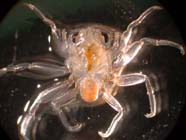
Microscopic photograph of a crab larva (megalops stage) from a plankton collection.
|
larva - a sexually immature juvenile stage of an animal's life cycle. However, there are a few exceptions, where the larval form never metamorphoses into the adult stage and is sexually mature (neoteny) |
laser line scan (LLS) - an electro-optic imaging technique which provides the efficiency and spatial coverage of a remote survey system, at an image resolution approaching that of visual observations. LLS produces high contrast underwater light field images, at millimeter to centimeter scale resolution and at two to five times the range of conventional video and photographic systems. Resolution and area covered by the images (swath width) vary with water clarity and tow height above the bottom |
lasonolide - a marine pharmaceutical, extracted from the sponge Forcepia sp., which possesses anti-tumor properties |
lateral - refers to the side or flank of an animal |
lateral display - a type of threat or reproductive behavior exhibited by many species of fishes, in which two male fish align beside each other, spread their dorsal, anal, and pelvic fins, and intensify the coloration of their bodies. These threats are usually accompanied by tail beats and body quivering |
lateral line scale - one of a series of scales that bear the pores and tubes of the lateral line system |

Note the lateral line of the Caribbean red snapper (Lutjanus purpureus) with 49 to 53 scales, which extend onto the base of the caudal fin. (Photo: U.S. Food and Drug Administration)
|
lateral line system - a series of sense organs that detect pressure or vibrations along the heads and sides of cyclostomes, fishes, and some amphibians. It consists of a network of sensory hair cell clusters (neuromasts) and small water-filled canals that lie immediately beneath the skin and extend along the sides of its body. This network is sensitive to external motion |
latitude - the angular distance between an imaginary line around the Earth, or any spherical body, parallel to its equator and the equator itself; an imaginary line around the Earth parallel to the equator |
launch - to start up any computer program by clicking on its icon or selecting it from the Start menu |
Law - a description of how a natural phenomenon will occur under certain circumstances; a statement that summarizes the results observed in an experiment that is repeated many times by many different scientists. A scientific law is widely accepted as true or as a fact, such as Newton's Laws of Gravitation |
Law of Conservation of Energy - energy can be transferred from one system to another in many forms, however, it can not be created nor destroyed. Thus, the total amount of energy available in the universe is constant |
Law of Parsimony (Occam's Razor) - when you have two competing theories which make exactly the same predictions, the one that is simpler is the better; also called "Occam's Razor" |
Law of the Minimum - the growth of a population is limited by the resource in shortest supply. Also known as 'Liebig's Law' |
law of tolerance - the presence, number, and distribution of species in an ecosystem are determined by whether the levels of one or more physical or chemical factors fall within the range tolerated by the species |
lay net - a stationary gillnet used in nearshore waters. Lay nets are also referred to as “set” nets or “moemoe” nets or "lay gillnets." The lay net is used passively. A panel of net is set in one location and direction and usually not actively tended. Fishes are caught as they swim into it and become entangled. The nets are commonly made of monofilament nylon which has been manufactured into netting with floats on one length and weights on the other length |
leachate - a liquid which has percolated through a soil and which carries substances in solution or suspension |
leaching - the movement of liquid into another material |
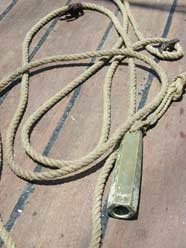
A lead line on the deck of a ship (Photo: Ocean Institute)
|
lead line - a line with a lead weight on the end used to measure depth. The lead is dropped into the water and marks on the line are read to determine the current water depth. The lead usually has a cavity to return a sample of the bottom type (mud, sand, etc.) |
least squares - a statistical criterion for the estimation of the goodness of fit in correlation analysis. Least squares methods aim to minimize the sum of squared differences between the observations and the predictions from a model |
lecithotrophic larva - a planktonic larva that gains its nutrition from yolk (semi-crystalline phospholipoprotein granules). In most bony fishes, yolk is supplied by the yolk sac, a bag-like ventral extension of the gut containing yolk granules |
lectotype - in taxonomy, one of several syntypes, designated by any author after the original publication of a species name as the 'type specimen' for the taxonomic name. Designated only where there was no original holotype |
LED (light emitting diode) - a very small light often used in electronic instrumentation |
leeward - referring to the side of an island or reef that faces away from the prevailing wind |
lek - a polygynous mating system where a number of males aggregate at a particular site during the breeding period and engage in courtship behavior, especially displays. Females attracted to the site "select " males for mating and subsequent fertilization of eggs. Once mated, the females usually go elsewhere to lay their eggs or to complete gestation. Lekking behavior (also called arena behavior) has been observed among cuttlefish, fishes, birds, antelope, and insects. Lekking species tend to stay at a single lek throughout a breeding season and to return to the same lek site from breeding period to breeding period |
lenticel - aerial roots (pneumatophores) of mangroves contain spongy tissue connected to the exterior of the root via small pores called lenticels. During low tide, when lenticels are exposed to the atmosphere, oxygen is absorbed from the air and transported to and even diffused out of the roots below ground. This diffusion of oxygen maintains an oxygenated microlayer around the roots that enhances nutrient uptake. |
leptocephalus larva - a long, ribbon-like larval form that is characteristic of eels, tarpons, and bonefishes |
lepton - a class of subatomic particles that constitute matter which have no measurable size and do not interact with the strong nuclear force. The charged leptons are the electron, the muon, the tau and their antiparticles. Neutral leptons are called neutrinos |
lesion - any pathological or traumatic discontinuity of tissue, or loss of function of a part |
lesion severity - the semiquantitative, subjective ranking of the degree of damage or extent of pathological change in the tissues of an organism |
lethal gene - a mutant form of a gene gene whose phenotypic effect eventually results in the death of the bearing organism. Death from different lethal genes may occur at any time, from fertilization of the egg to advanced age. Lethal genes may be dominant, incompletely dominant, or recessive; also called a 'lethal allele' |
leucocyte - a cellular component of blood. Leucocytes help to defend the organism's body against infectious disease and foreign materials as part of the immune system; also called "white blood cell" |
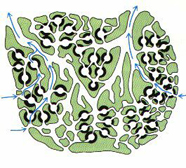
Leuconoid sponges represent the most complex body form. The canal system is extensively branched. Usually there are many oscula in each sponge.(Illustration: www-biol.paisely.ac.uk)
|
leuconoid - the body form of highest complexity in sponges. The leucanoid form is highly irregular, displays the greatest degree of folding of the body wall, and has lost radial symmetry. The choanocytes line the pockets formed by the convoluted body wall |
leucophore - a colorless chromatophore which contains purines, usually guanine, in the form of small, motile crystals in the cell's cytoplasm |
levee - a raised embankment along the edge of a river channel. Natural levees result from periodic overbank flooding, when coarser sediment is immediately deposited because of a reduction in river velocity. Levees are often constructed by humans living in low-lying areas as protection against flooding |
library - in genomics, an unordered collection of clones (i.e., cloned DNA from a particular organism) whose relationship to each other can be established by physical mapping |
LIDAR (Light Detection And Ranging) - a remote-sensing technique that uses a laser light source to probe the characteristics of a surface target. A laser emission may be directed downward from a low flying aircraft. Information about the target is derived from back-scattered reflectance or fluorescence of the target. Chlorophyll pigments in coral reef organisms (e.g., algae, seagrasses, coral), when excited by shorter (blue or green) wavelength light, emit light at longer (red) wavelengths, i.e., it fluoresces |
life - there is no universal definition of life. Different scientists have proposed a variety of similar definitions which describe life as a process that exists within cells and has the following attributes: homeostasis, organization, metabolism, growth, reproduction, response to stimuli, and adaptation to the environment |
life cycle - the complete succession of developmental changes undergone by an organism during its life, from fertilized egg (zygote) to maturity when another fertilized egg can be produced |
ligand - a molecule, such as a hormone or growth factor, that binds to a specific site on a receptor protein |
ligase - an enzyme used to join DNA (DNA ligase) or RNA (RNA ligase) segments together |
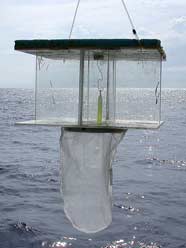
A light trap. At night, adult and larval fishes are attracted to chemical light sticks or fluorescent lights inside the traps and are able to enter through openings on the sides. They are then unable to find their way out. (Photo: Australian Museum)
|
light trap - a stationary or floating collecting apparatus that contains a light source, e.g., a chemical glow light, which attracts larval, juvenile, and adult fishes, as well as invertebrates. The animals enter the trap through small holes or funnels and then are unable to find their way out |
limnology - the study of the physical, chemical, meteorological and biological aspects of fresh waters |
limoniform - lemon-shaped |
limu - general Hawaiian name for all kinds of aquatic plants and soft corals; also terrestrial algae growing in any damp place on the ground, on rocks, and on other plants |
limu kohu - the Hawaiian name for the red alga, Asparagopsis taxiformis, an edible species that is no longer common in the Main Hawaiian Islands, but is relatively abundant the shallow waters of some of the Northwestern Hawaiian Islands |
line intercept transect - a linear transect protocol where a tape is secured at each end of the transect with the tape draped over the reef in between. Observations are collected on each species and substrate component and their length under the tape |
Line Islands - a chain of eleven atolls and low coral islands in the central Pacific Ocean, south of the Hawaiian Islands. Eight of them belong to Kiribati, while three are United States territories grouped with the United States Minor Outlying Islands. The chain stretches for over 2,000 km north to south, and has a combined land area of around 425 km², with most of this total being contributed to by the large atoll of Kiritimati. Eight of the islands (Flint, Kiritimati, Malden, Millennium Atoll, Tabuaeran, Teraina, Starbuck and Vostok) are part of the Republic of Kiribati. Jarvis Island, Kingman Reef and Palmyra are uninhabited, unincorporated territories of the United States, managed as part of the Pacific/Remote Islands National Wildlife Refuge complex |
line precedence - in taxonomy, when two different names for the same taxon are first published in the same publication, then the one which appears on the earlier line has line precedence. Line precedence does not necessarily mean priority as well. This is determined by the action of the first reviser |
lineage - a genetically continuous line of evolutionary descent |
linear acceleration - the rate of change of velocity in a linear direction (along a straight line) with respect to time |
linear reef - a linear coral formation that is oriented parallel to the shore or the shelf edge |
linear regression - regression in which the relationship is linear |
linear relationship - a situation in which the best-fitting regression line is a straight line |
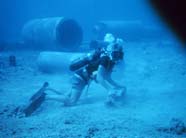
A NOAA scientist laying out a linear transect line.
|
linear transect - a line of specified length laid out within a study site. They are generally positioned parallel to the shore along depth contours. Measurements and observations may be taken along the entire surface beneath the line (line intercept transect) or at specified intervals along the line (point intercept transect) |
linguiform - tongue-shaped |
linkage - the proximity of two or more markers (genes, etc.) on a chromosome; the closer together the markers are, the lower the probability that they will be separated during DNA repair or replication processes, and hence the greater the probability that they will be inherited together |
linked genes - genes that are so closely associated on a chromosome that the allelic forms found on a chromosome are inherited together by an offspring at least 80 percent or more of the time |
Linnaean tautonymy - in taxonomy,the identical spelling of a new genus-group name and a pre-Linnaean (i.e., before 1758) one-word name cited as a synonym of only one of the species or subspecies originally included in that genus |

In the 18th century, Linnaeus made a great contribution to science by developing systems of classification and nomenclature to organize the explosion of information on plants and animals. The tenth edition (1758-59), of Linnaeus's classic work, Systema Naturae, was chosen as the starting point for zoological nomenclature. (Photo: Smithsonian Institution Libraries)
|
Linnaeus, Carolus - the 18th century Swedish botanist (1707-1778) who established the modern binomial system of biological nomenclature for plants and animals. His non-latinized name was Carl von Linne |
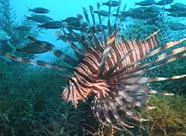
The lionfish, Pterois volitans, is a recent invasive species in the western Atlantic Ocean. Like some other members of the scorpion fish family, the lionfish is a venomous animal, possessing venom glands at the base of the dorsal, anal and pelvic fin spines. The venom is injected in a potential predator via the spines. The genus Pterois contains eight species variously referred to as lionfishes, turkeyfishes, or firefishes. The lionfish is an inhabitant of near and offshore coral and rocky reefs. During the day, it seems to prefer shelter under ledges or in caves or crevices. (Photo: Paula Whitfield, NOAA Beaufort Laboratory)
|
lionfish - the red lionfish (Pterois volitans) is a venemous coral reef fish belonging to the scorpion fish family (Scorpaenidae). Native to the Indian and western Pacific oceans, lionfish are now an invasive species found in the western Atlantic Ocean from southern Florida to New York and Bermuda. They appear to be a reproducing along the southeastern U.S. coast; Other common names are turkeyfish, dragonfish, and firefish |
lipase - an enzyme, secreted by the pancreas and the glands of the small intestine, that breaks down fats into glycerol and fatty acids during digestion |
lipid - a group of organic compounds, including the fats, oils, waxes, steroids, and triglycerides, that are insoluble in water but soluble in common organic solvents, and are oily to the touch. Together with carbohydrates and proteins, lipids constitute the principal structural materials of cells |
lipopolysaccharide - a compound containing a lipid bound to a polysaccharide |
liposome - an artificial, single or multilaminar vesicle, made from a lipid, that is used for the delivery of a variety of biological molecules or molecular complexes to cells, e.g., drug delivery and gene transfer. Liposomes are also used to study membranes and membrane proteins |
Listserv ® - the most common kind of maillist found on the internet |
lithoherm - a type of deep water reef composed of surface hardened layers of lithified sandy carbonate sediments supporting a diverse array of benthic fauna, including deep water corals |
lithosphere - the outer solid part of the earth, including the crust and uppermost mantle. The lithosphere is about 80-100 km thick, although its thickness is age dependent The lithosphere below the crust is brittle enough at some locations to produce earthquakes by faulting, such as within a subducted oceanic plate |
Lithothamnion ridge - a synonym for algal ridge. The algal genus Lithothamnion is important in maintaining reef integrity by cementing various pieces of calcium carbonate |
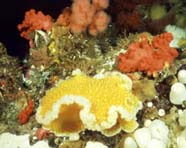
This sea slug is a denizen of northwest U.S. rocky littoral (intertidal) zones.
|
littoral - intertidal; between low and high tide levels |
live fish food trade - a global system that links fishing communities with markets, primarily in Hong Kong and mainland China. Many of the fish are captured on coral reefs in Southeast Asia or the Pacific Island nations. Within the live food trade there are certain types of fish demanded more frequently by consumers, particularly smaller and medium sized fish. consumers are willing to pay large amounts of money on rare and fresh fish. Fishes captured on coral reefs are the most valued fish in the trade. Hong Kong and China are the dominant markets for the live fish, in addition to other cities in the region that have large Chinese populations, including Singapore and Kuala Lumpur. In upscale restaurants across Southeast Asia, diners can feast on live reef fish for up to $100 per kg |
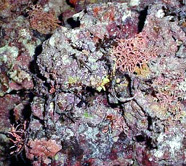
Live rock from Tonga, crated for shipping to an aquarist. (Photo: http://www.reefscience.com)
|
live rock - calcareous rock which is removed from the vicinity of a coral reef with some of the life forms on it still living. These may include bacteria, coralline algae, sponges, worms, crustaceans and other invertebrates. Live rock is commonly used in reef aquaria because it contains bacteria that can help filter the water through nitrification |
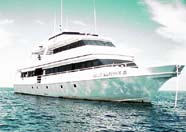
A liveaboard dive boat designed and constructed with divers and underwater photographers in mind. A vessel such as this may accommodate up to 20 passengers in private cabins, all with full bathrooms. It is fully air-conditioned with a state-of-the-art dive center, and complete photo and video labs with daily E6 processing. Wide dive platforms provide easy water entries and exits. (Photo: Belize Aggressor)
|
liveaboard - a commercial dive boat with sleeping and eating accommodations. Scuba divers live aboard the boat for several days and usually visit dive locations unaccessible to other divers |
living tag - a type of tagging method for marine turtles in which a small piece of tissue is taken from the white plastron of a hatchling and implanted in one of the dark scutes of the carapace. The white patch grows with the scute, and the particular scute which has been marked, codes for the year that the turtle was tagged |
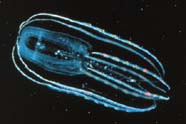
This comb jelly (ctenophore) possesses a lobate shape. (Photo: NOAA)
|
lobate - lobe-shaped |
lobe - a rounded projection |
Local Action Strategy (LAS) - a U.S. Coral Reef Task Force led initiative to identify and implement priority actions needed to reduce key threats to valuable coral reef resources in each U.S. coral reef jurisdiction. In 2002, the Task Force adopted the “Puerto Rico Resolution” which calls for the development of three-year LAS by each of the seven U.S. jurisdictions containing coral reefs: Florida, Puerto Rico, the U.S. Virgin Islands, Hawaii, Guam, American Samoa, and the Commonwealth of the Northern Mariana Islands. These LAS are locally-driven roadmaps for collaborative and cooperative action among federal, state, territory, and non-governmental partners |
local extinction - the disappearance of a population from a local area. Local extinctions can accumulate into regional extinctions |
Locally-Managed Marine Area (LMMA) - an area of nearshore waters actively being managed by local communities or resource-owning groups, or being collaboratively managed by resident communities with local government and/or partner organizations. An LMMA can vary widely in purpose and design; however, two aspects remain constant: a well-defined or designated area; and substantial involvement of communities and/or local governments in decision-making and implementation |
Locally-Managed Marine Area (LMMA) Network - a group of LMMA practitioners involved in various marine conservation projects around the globe who have joined together to increase the success of their efforts. The LMMA Network is a learning network, meaning that participating projects use a common strategy and work together to achieve goals. The Network is interested in learning under what conditions using an LMMA strategy works, doesn’t work, and why. Network members share knowledge, skills, resources and information in order to collectively learn how to improve marine management activities and increase conservation impact |
locomotion - the act of moving, or the ability to move, from place to place |
loculus - the calcified area or fiber-filled space within the axis of a gorgonian or an interseptal space within the gastrovascular cavity of an anthozoan; a small cavity or space within an organ of a plant or animal |
locus - the position of a gene, DNA marker, or genetic marker on a chromosome |
logarithmic phase - the steepest slope of the growth curve of a culture; the phase of vigorous growth during which cell number doubles every 20-30 minutes; also called 'log or exponential growth phase' |
logarithmic scale - a constant ratio scale in which equal distances on the scale represent equal ratios of increase. For example, in a logarithmic scale, the distance between 10 and 100 is the same as the distance between 100 and 1000, or between 1000 and 10,000. Logarithmic scales are used when the range of numbers being represented is large |
long line fishing - a commercial fishing method which uses hundreds to thousands of baited hooks hanging from a single line, which may be kilometers in length |
long term monitoring - the repeated surveying of organisms, populations, communities, or environmental parameters over time to help us understand a variety of natural processes |
longitude - an imaginary great circle on the surface of the Earth passing through the north and south poles at right angles to the equator; "all points on the same meridian have the same longitude" |
longshore current - a current that flows parallel to the shore just inside the surf zone. It is also called the littoral current |
Lophelia pertusa - the scleractinian species, Lophelia pertusa, is the most important global constituent of deep-water coral reefs, forming massive complexes hundreds of kilometers long and up to 30 meters high. L. pertusa is a widespread structure-forming deep-water species occurring in the Atlantic, Pacific, Indian, and Southern Oceans, with a latitudinal range from about 56º S to 71º N and a depth range from 39 to over 1,000 meters |
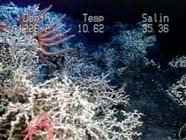
This photo of a Lophelia coral garden was taken via a manned submersible on the ocean floor. (Photo: NOAA)
|
Lophelia reef - a reef formed by Lophelia pertusa, a deep-sea coral found in all oceans except the Arctic Ocean |
lophocyte - a mobile cell in sponges that produces collagen |
lophophorate - an informal taxonomic unit that includes coleomatic metazoans which possess a specialized filter-feeding organ, the lophophore. Almost all lophophorates are marine organisms and all are suspension feeders. Lophophorates are deutersotomes and are typically considered relatively closely related to chordates and echinoderms. There are three lophophorate phyla: Phoronida, Bryozoa and Brachiopoda |
lophophore - a feeding organ possessed by lophorates. It is a disk or horseshoe-shaped structure which surrounds the mouth and bears the tentacles of the Bryozoa (moss animals), Brachiopoda (lamp shells) and Phoronida (horseshoe worms). The tentacles are hollow (coelomic) and covered with cilia which generate water currents that draw food toward the mouth |
LORAN (LOng RAnge Navigation) - a navigation system developed in the 1950's based on the time displacement between signals from two or more fixed shore based antennae |
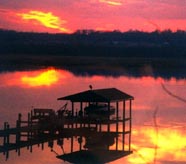
A peaceful lotic environment, the Patuxent River, eastern Maryland, in December 2000. (Photo: Mary Hollinger, NOAA/National Oceanographic Data Center)
|
lotic - refers to a flowing or running body of fresh water, i.e., streams and rivers |
low recruitment - a low influx of new members into a population by reproduction or immigration |
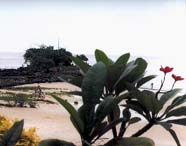
A small island at the mouth of the Amazon River at low tide. See high tide for contrast. (Photo: Alessandra and Michael)
|
low tide - the lowest level of the tide; the minimum height reached by each falling tide |
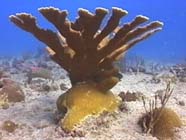
A young Acropora palmata colony in St. Croix, U.S. Virgin Islands (Photo: J. Halas)
|
lower palmata zone - the part of a reef crest that is seaward of the palmata zone. It consists primarily of elkhorn coral (Acropora palmata) at a depth of about 3-6 m in Caribbean reefs |
lower risk - a species or other taxonomic group that has been evaluated but does not not face a risk of extinction in the wild |
lowland - a general term for low-lying land or an extensive region of relatively low relief; usually applied to coastal regions that do not rise high above sea level |
luciferase - the enzyme which activates luciferin, in the presence of ATP, to produce bioluminescence |
luciferin - a compound whose activated form emits light. In the presence of the enzyme luciferase and ATP, luciferin is oxidized to produce oxyluciferin and energy given off as cold light (bioluminescence) |
lumen - the interior space of a tubular organ, such as a blood vessel or an intestine |
lumen - unit of luminous flux |
luminous - emitting light. |
luminous flux - the rate of flow of light energy |
lumisome - in some cnidarians, a small, intracellular membrane-enclosed vesicle which contains all the proteins necessary for bioluminescence |
lumper - refers to a taxonomist who focuses more on similarities than differences among taxa, discounting the importance of minor variation among individuals, and who tends to recognize fewer taxa |
lunar tide - the portion of the tide that can be attributed directly to attraction to the moon |

Blue tangs with lunate-shaped caudal fins. (Photo: NOAA)
|
lunate - crescent-shaped |
lux - unit of illumination equal to one lumen per square meter |
lycra - a spandex textile fiber which has unique elastic qualities in that it can be used in very lightweight, durable fabrics of long-lasting elasticity. It has excellent tensile strength, a long flex life, and high resistance to abrasion and heat degradation. Lycra skin coverings are popular with scuba divers as they give some protecion against abrasions and jellyfish and fire coral stings. They also offer (minimal) protection against cold |
lysis - the breakdown of a cell caused by rupture of its cell membrane and loss of cytoplasm. Lysis can be caused by viral action, chemical or physical means; to break down |
lysosome - an organelle that contains digestive enzymes (acid hydrolases). They digest excess or worn out organelles, food particles, and engulfed viruses or bacteria. The membrane surrounding a lysosome prevents the digestive enzymes inside from destroying the cell |
|
|
|
|

